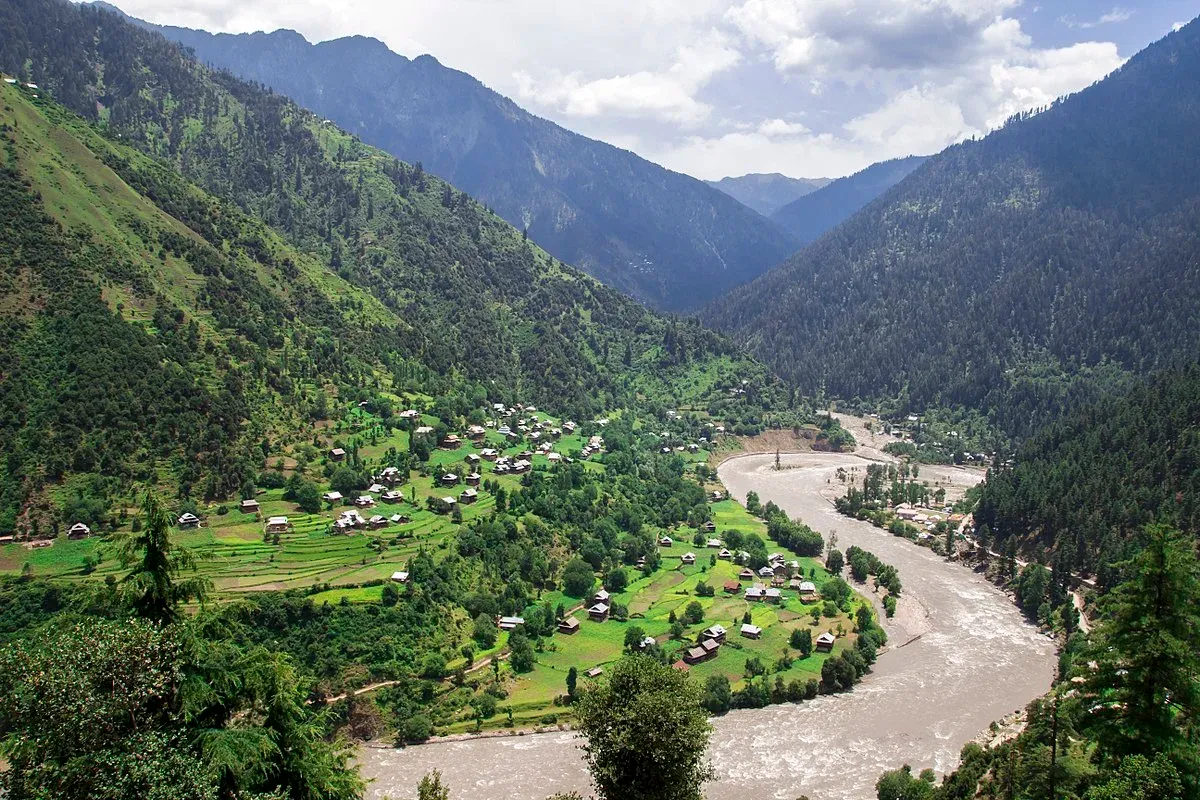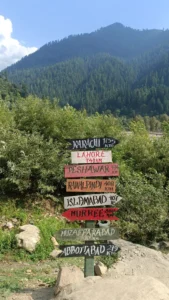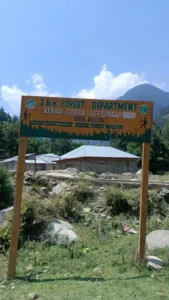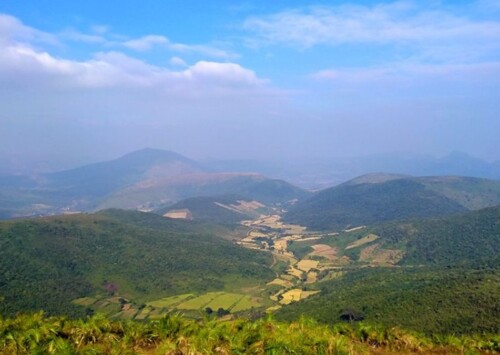Keran Valley: A journey to Kashmir’s borderland beauty
From militarised zone to a familial & tourist destination

Kishanganga River, which originates in Kashmir and later joins the Neelam River in PoK, is the defining feature of this landscape
Keran Valley, nestled along the Line of Control in Kashmir, offers a rare glimpse into life at the border. Once inaccessible to civilians, this region now welcomes visitors to witness its beauty, history, and quiet human connections.

Kishanganga River, which originates in Kashmir and later joins the Neelam River in PoK, is the defining feature of this landscape
Keran, a remote village in the Kupwara district of Jammu and Kashmir, lies about 130 kilometres from Srinagar, along the banks of the Kishanganga River and almost on the Line of Control (LoC), which serves as the de-facto border between India and Pakistan.
Once an isolated and heavily militarised zone, Kishanganga was inaccessible to outsiders for decades. Only the military and local villagers, living under strict surveillance, had any connection to these lands. The idea of visiting such areas was unimaginable.
However, a significant shift occurred in 2022, when parts of the LoC were opened to visitors, allowing them to experience not just the raw, untouched beauty of the region but also the deep human connections that persist despite years of division. One such place is Kishanganga, also known as Neelam Valley, located in the Keran sector. Nestled between towering mountains and the pristine Kishanganga River, the valley offers breathtaking views and an unparalleled experience.
But beyond its stunning landscape, it provides a rare and poignant glimpse across the border—into Pakistan-occupied Kashmir, just across the river. The river that divides them has witnessed decades of conflict, yet it silently carries the shared history and culture of both sides, making Kishanganga an extraordinary place where beauty, history, and human resilience converge.

Here, one can witness everyday life unfolding in the villages across the LoC, see children playing in schoolyards, and even exchange waves and greetings with people just a few metres away.
But reaching Kishanganga is no simple feat. Unlike the popular tourist spots of Kashmir, where modern infrastructure makes travel convenient, the journey to Kishanganga is an adventure in itself. The roads leading to Kishanganga in Keran, the last Indian village before the LoC, are rough, winding through mountains that seem untouched by time.
As travellers approach Keran, the surroundings change. The villages here are far removed from modern technology, the mobile network is weak, there is no internet and there are no tall buildings. People here live a simple, self-sustained life, in harmony with nature. It is a place where the fast pace of urban life fades away, replaced by the sound of the river and the occasional chatter of villagers.
About 3 km before the LoC, all visitors are required to leave their vehicles and proceed on foot. A military checkpoint marks the beginning of this next phase, where identity cards are checked, and security personnel ensure that only those with valid identification continue forward. Surveillance is tight, with cameras installed across the border area, monitoring every movement.
Trekking along the Kishanganga River
Unlike traditional treks through dense forests or steep mountain trails, the path to Kishanganga follows the edge of the river itself. The Kishanganga River, which originates in Kashmir and later joins the Neelam River in PoK, is the defining feature of this landscape. It also serves as the literal border between the two countries, a natural divider that has seen decades of conflict and yet, in its flowing waters, carries the shared history of both sides.
The trek is both mesmerising and exhausting. The terrain is uneven, with loose stones and patches of grass, requiring careful footing. The river gushes alongside, its waters icy cold even in the summer months, glistening under the sun. The wind that rises from the water carries a cool, refreshing touch, making the journey slightly easier despite the difficulty of the path.
After nearly an hour-long trek, the LoC comes into full view. But unlike other international borders marked by barbed wire and massive fencing, here, the division is simply the river itself. There are no gates to cross, no physical barriers just a natural line drawn by nature in the form of flowing water.
When the villagers across the LoC notice the visitors, some of them wave in curiosity. In return, travellers on the Indian side instinctively raise their hands in greeting. There is no formal interaction, no spoken words, but in those silent gestures, an unspoken connection is made.

Unlike some reports of border meetings elsewhere, no sweets or gifts are exchanged here. As it is a highly-sensitive zone, which is extremely prone to incursions by militants and Pakistani Army, the border is strictly monitored, and movement beyond the allowed area is not permitted. However, the warmth of these brief interactions is unmistakable. It is a powerful experience to stand there, to see people just a few meters away, separated by nothing but water and history.
As one walks, the villages across the LoC is clearly visible on the other side. The proximity is surreal, just across the river, life continues as if there were no borders at all. Men can be seen working in the fields, women wash clothes on the riverbank, and children run along the dirt roads of their villages. The sound of their daily lives, laughter, casual conversations, even the occasional call from a mother to her child, drifts over across the river to the Indian side.
One of the most profound moments of the trek is when the Azaan (Islamic call to prayer) echoes from across the border. The deep, rhythmic call to prayer resonates through the valley, carried by the wind, reaching the ears of people on both sides of the river. It is a powerful moment, a reminder of the shared culture and traditions that no border can erase.
For travellers used to the comfort of modern technology, this trek is a step back in time. There is no mobile network, no GPS to guide the way, only the river, the mountains, and the dirt path leading toward the LoC. It is a place where one is truly disconnected from the digital world, yet, paradoxically, more connected to history, to nature, and to the unfiltered reality of life along a border.
Spending a night in Keran, by the banks of the Kishanganga River, is an experience that lingers in memory long after leaving. As the sun sets behind the towering mountains, the valley is bathed in hues of orange, pink, and gold, creating a mesmerising spectacle. The gentle murmur of the river, combined with the cool mountain breeze, creates an atmosphere of peace and solitude rarely found elsewhere. Whether staying in a tent pitched near the river or in a cosy homestay, the experience is deeply immersive, far from city lights and noise, under a sky filled with countless stars. The locals, with their warm hospitality and home-cooked meals, make the stay even more special, offering traditional Kashmiri dishes made from fresh and locally-sourced ingredients.
As night falls, Keran transforms into a dreamlike setting. The air is crisp and pure, with the only sounds being the rustling of leaves, the distant hoot of an owl and the rhythmic flow of the river. Sitting around a small bonfire, sipping Kashmiri Kahwa, and listening to stories from locals about life near the border adds to the magic of the place. With no distractions from technology, one feels more connected to nature, embracing the simplicity and raw beauty of the valley. Waking up to the soft glow of dawn, with mist rolling over the river and birds chirping in the walnut groves, is a reminder of how rare and precious such moments are in today’s fast-paced world.
For many Kashmiri families, Kishanganga is more than just a place of natural beauty it is a place of longing, of stories, of memories lost in the tides of history. Many families were divided during the partition in 1947 and the wars that followed. Some have never met their relatives on the other side, only knowing them through letters and occasional phone calls.
For years, there were no means of even seeing their ancestral lands, but now, with the opening of border tourism, they can at least catch a glimpse of what once was theirs. Some older visitors stand silently at the LoC, looking across the river, their eyes reflecting both joy and sorrow.
The history behind the LoC
Before 1947, Kashmir was a unified region, where people moved freely between villages, trading, celebrating festivals, and visiting relatives across what is now the LoC. However, when India and Pakistan gained independence from British rule, the princely state of Jammu and Kashmir became a major point of contention between the two newly formed nations. The first Indo-Pakistani war broke out in 1947-48, leading to a ceasefire brokered by the United Nations in 1949. This ceasefire resulted in the establishment of the Ceasefire Line, dividing Kashmir into two parts—one administered by India and the other by Pakistan. The line, meant to be temporary, soon became a permanent geopolitical reality, cutting off families, friends, and entire communities who once lived as one.
Subsequent wars in 1965 and 1971 further deepened the division, and after the Simla Agreement of 1972, the Ceasefire Line was officially renamed the LoC. Over the decades, the LoC remained a highly militarised zone, with frequent cross-border skirmishes and restrictions on civilian movement. For locals living near the border, life became one of constant uncertainty, with strict security measures and limited access to the outside world. However, in recent years, efforts have been made to ease tensions, and initiatives like border tourism in places like Kishanganga have emerged as symbols of peace and reconciliation. While the historical scars of partition remain, these small steps toward greater people-to-people interaction offer hope for a future where borders may not separate hearts and cultures as they once did.









